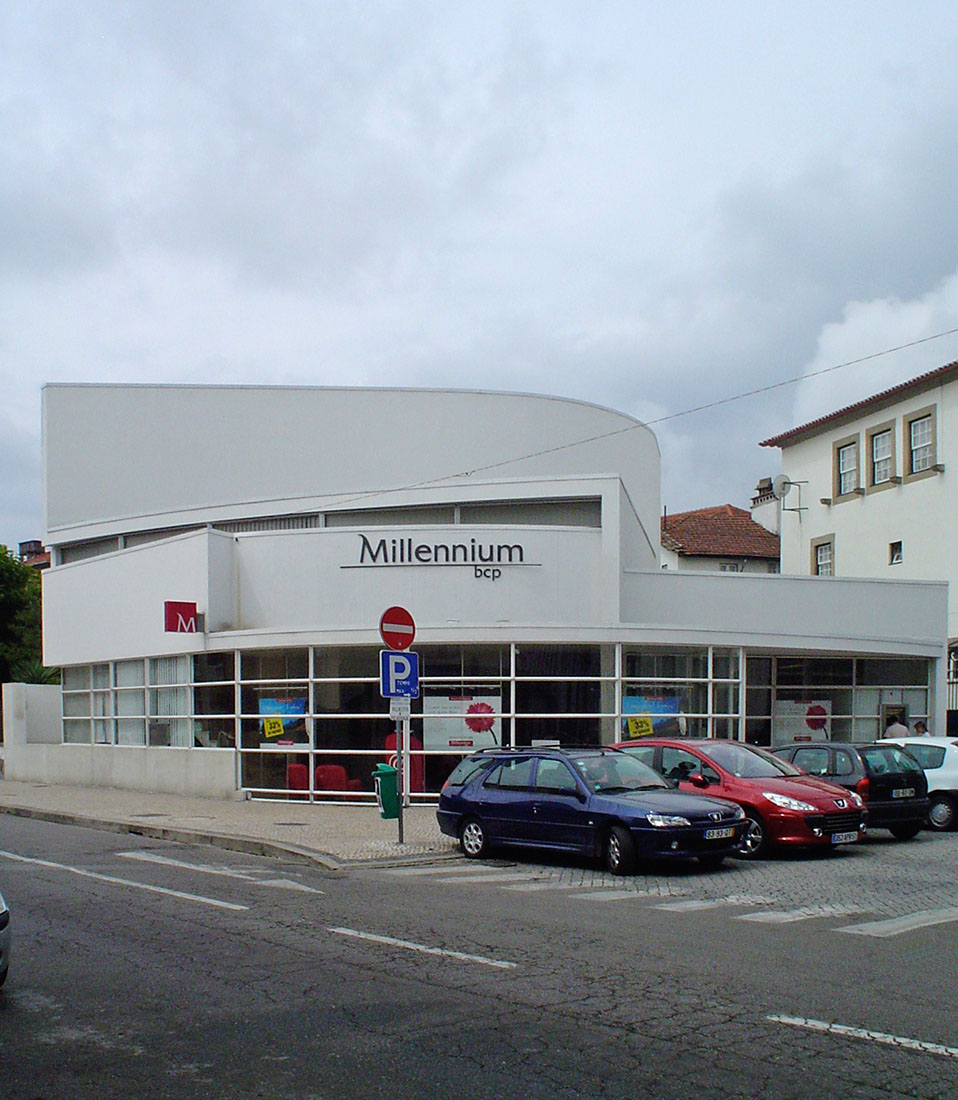 |
 |
 |
 |

Banco Pinto & Sotto Mayor
Avenida Dr. António José de Almeida Oliveira de Azeméis
1971 - 1974
At the beginning of the 1970s the Portuguese architect Álvaro Siza Vieira
completed several small-scale projects in the north of Portugal, close
to his hometown Porto. These projects belong to his early maturity and
are regarde as key projects for his further development. Probably the most relevant of this projects is the Banco Pinto & Sotto Mayor in the small town of Oliveira de Azeméis.
The bank building is located on the main street of the village, on a
square that connects two different levels. It is considered as a
complex spatial experiment, proposing an
unexpected way of moving through the building. It is marked by a
complex geometry, which is carefully controlled. For this reason, the
architect draw a large amount of plans, sections and perspectives
showing interior and exterior. Several small-scale
paper models pay attention to the formal aspects of the complex
geometry. The three superimposed curves define three floors, which are
stepped back with increasing height. By this measure the adjacent
building from the 18th century is not pushed into the background. The
stepped volume with all its curves is to be considered as
a subtle response to the built environment. At the same time, the white
building with large windows strongly contrasts with the neighboring
edification and successfully claims autonomy for itself. As a new
element, it is inserted into the existing urban texture without
dominating it. The architect
created complex relationship between the interior and exterior spaces
of the bank agency. The interlocking rooms give the impression of a
vast, almost unlimited interior. The consciously selected visual
connections are precise responses to movements in the building and
around the building. Today, the building is a branch of the Millennium
BCP Bank. In June 2012, the Museum of Modern Art (MoMA) in New York
acquired several models, photographs and sketches of this project.
Anfang der 1970er Jahre konnte der portugiesische Architekt Álvaro Siza Vieira mehrere Kleinprojekte im Norden Portugals, in der Nähe seiner Heimatstadt Porto, fertigstellen. Diese Projekte gehören zu seiner frühen Reife und sind als Schlüsselprojekte für seine Weiterentwicklung zu betrachten. Wahrscheinlich das wichtigste dieser Projekte ist der Banco Pinto & Sotto Maior in der kleinen Stadt Oliveira de Azeméis. Das Bankgebäude befindet sich direkt an der Hauptstrasse des Ortes, an einem Platz, der zwei unterschiedliche Ebenen miteinander verbindet. Das Gebäude wird als ein komplexes räumliches Experiment betrachtet und sieht eine unerwartete Bewegungsweise durch das Gebäude vor. Das Bankgebäude ist durch eine komplexe Geometrie gekennzeichnet, welche sorgfältig kontrolliert wurde. Zu diesem Zweck zeichnete der Architekt eine grosse Anzahl von Grundrissen, Schnitten sowie Innen- und Aussenperspektiven. Mehrere kleinformatige Papiermodelle achten auf die formalen Aspekte der komplexen Geometrie. Die drei übereinander liegende Kurven definieren drei Stockwerke, welche sich mit zunehmender Höhe zurückstaffeln. Dadurch wird das benachbarte Gebäude aus dem 18. Jahrhundert nicht in den Hintergrund verdrängt. Das abgestufte Volumen mit all seinen Kurven ist als eine subtile Antwort auf die gebaute Umgebung zu betrachten. Gleichzeitig steht das weisse Gebäude mit seinen grossen Fenstern in starkem Kontrast zur benachbarten Bebauung und behauptet erfolgreich seine Autonomie. Als neuartiges Element wird es in die bestehende Textur eingefügt ohne diese zu dominieren. Mit diesem Entwurf schuf der Architekt eine komplexe Beziehung zwischen Innen- und Aussenräumen der Bankagentur. Die ineinander greifenden Räume erwecken den Eindruck eines weiten, beinahe unbegrenzten Innenraumes. Die bewusst gewählten Sichtverbindungen sind präzise Reaktionen auf Bewegungsabläufe im Gebäude und um das Gebäude herum. Heute ist das Gebäude eine Filale der Millennium BCP Bank. Im Juni 2012 erwarb das Museum of Modern Art (MoMA) in New York Modelle, Fotografien und Skizzen dieser Arbeit.
Anfang der 1970er Jahre konnte der portugiesische Architekt Álvaro Siza Vieira mehrere Kleinprojekte im Norden Portugals, in der Nähe seiner Heimatstadt Porto, fertigstellen. Diese Projekte gehören zu seiner frühen Reife und sind als Schlüsselprojekte für seine Weiterentwicklung zu betrachten. Wahrscheinlich das wichtigste dieser Projekte ist der Banco Pinto & Sotto Maior in der kleinen Stadt Oliveira de Azeméis. Das Bankgebäude befindet sich direkt an der Hauptstrasse des Ortes, an einem Platz, der zwei unterschiedliche Ebenen miteinander verbindet. Das Gebäude wird als ein komplexes räumliches Experiment betrachtet und sieht eine unerwartete Bewegungsweise durch das Gebäude vor. Das Bankgebäude ist durch eine komplexe Geometrie gekennzeichnet, welche sorgfältig kontrolliert wurde. Zu diesem Zweck zeichnete der Architekt eine grosse Anzahl von Grundrissen, Schnitten sowie Innen- und Aussenperspektiven. Mehrere kleinformatige Papiermodelle achten auf die formalen Aspekte der komplexen Geometrie. Die drei übereinander liegende Kurven definieren drei Stockwerke, welche sich mit zunehmender Höhe zurückstaffeln. Dadurch wird das benachbarte Gebäude aus dem 18. Jahrhundert nicht in den Hintergrund verdrängt. Das abgestufte Volumen mit all seinen Kurven ist als eine subtile Antwort auf die gebaute Umgebung zu betrachten. Gleichzeitig steht das weisse Gebäude mit seinen grossen Fenstern in starkem Kontrast zur benachbarten Bebauung und behauptet erfolgreich seine Autonomie. Als neuartiges Element wird es in die bestehende Textur eingefügt ohne diese zu dominieren. Mit diesem Entwurf schuf der Architekt eine komplexe Beziehung zwischen Innen- und Aussenräumen der Bankagentur. Die ineinander greifenden Räume erwecken den Eindruck eines weiten, beinahe unbegrenzten Innenraumes. Die bewusst gewählten Sichtverbindungen sind präzise Reaktionen auf Bewegungsabläufe im Gebäude und um das Gebäude herum. Heute ist das Gebäude eine Filale der Millennium BCP Bank. Im Juni 2012 erwarb das Museum of Modern Art (MoMA) in New York Modelle, Fotografien und Skizzen dieser Arbeit.
